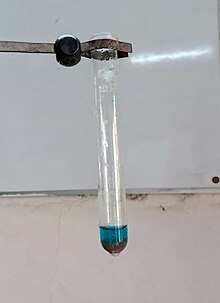|
Barfoed's test
Barfoed's test is a chemical test used for detecting the presence of monosaccharides. It is based on the reduction of copper(II) acetate to copper(I) oxide (Cu2O), which forms a brick-red precipitate.[1][2]
(Disaccharides may also react, but the reaction is much slower.) The aldehyde group of the monosaccharide which normally forms a cyclic hemiacetal is oxidized to the carboxylate. A number of other substances, including sodium chloride,[3] may interfere. Its author is the Danish chemist Christen Thomsen Barfoed[1] and it is primarily used in botany.[citation needed] The test is similar to the reaction of Fehling's solution to aldehydes. CompositionBarfoed's reagent consists of a 0.33 molar solution of copper (II) acetate in 1% acetic acid solution.[4] The reagent does not keep well and it is therefore advisable to make it up when it is actually required.[5] Procedure1 drops of Barfoed's reagent is added to 2 mL of given sample in a test tube and boiled for 3 minutes and then allowed to cool. If a red precipitate occurs, a monosaccharide is present. References
|
||||||
Portal di Ensiklopedia Dunia
